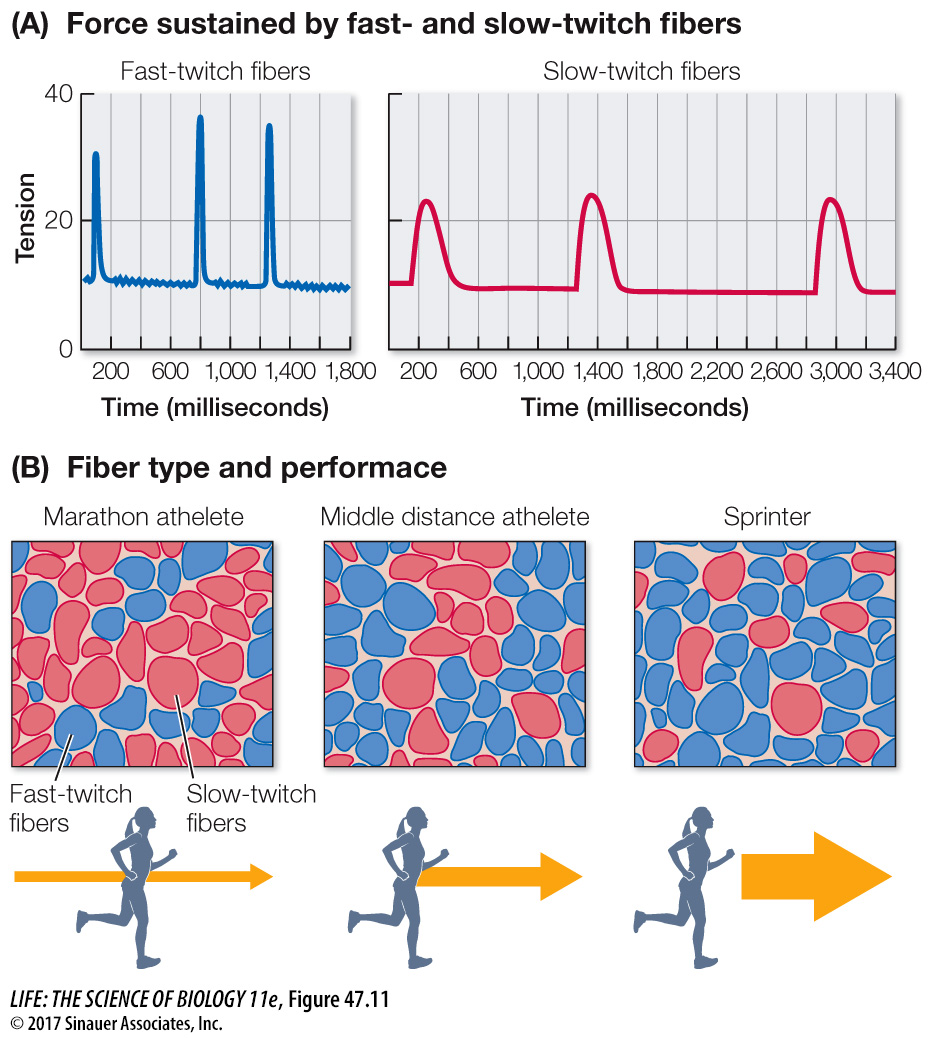Muscle fiber types determine endurance and strength
Not all skeletal muscle fibers are alike, and a single muscle often contains more than one type of fiber. The two major types of skeletal muscle fibers express different genes for their myosin molecules, and these myosin variants have different rates of ATPase activity. Those with high ATPase activity can recycle their actin–myosin cross-bridges rapidly and are therefore called fast-twitch fibers; those with lower ATPase activity are called slow-twitch fibers, and they develop tension more slowly but can maintain it longer (Figure 47.11A).

Figure 47.11 Fast- and Slow-Twitch Muscle Fibers (A) Fast-twitch fibers generate a large force quickly but fatigue rapidly. Slow-twitch fibers generate smaller forces, and do so more slowly, but can sustain them for a longer time. (B) The skeletal muscles in these three panels show slow-twitch fibers as red and fast-twitch fibers as blue. Arrows represent the duration (length) and speed (thickness) of running.
Question
Q: What would you expect the muscle fiber distribution to be in a champion weight lifter?
A champion weight lifter is likely to have muscles with a high proportion of fast-twitch fibers.
Slow-twitch fibers are also called oxidative or red muscle because they contain especially large amounts of myoglobin (an oxygen-binding protein similar to the hemoglobin in red blood cells), have many mitochondria, and are well supplied with blood vessels. These characteristics increase the fibers’ capacity for oxidative metabolism and result in their red appearance. The maximum tension a slow-twitch fiber produces is low and develops slowly but is highly resistant to fatigue. Slow-twitch fibers have substantial reserves of fuel, mostly lipids, so they can maintain steady, prolonged production of ATP as long as oxygen is available. Muscles with high proportions of slow-twitch fibers are good for long-term aerobic work (that is, work that requires oxygen). Long-distance runners, swimmers, cyclists, and other athletes whose activities require endurance have leg and arm muscles consisting mostly of slow-twitch fibers (Figure 47.11B).
Fast-twitch fibers, also called glycolytic or white muscle, have few mitochondria, little or no myoglobin, and fewer blood vessels; thus they look pale. Their major energy source is glycolysis, and therefore their major stored fuel is glycogen. Fast-twitch glycolytic fibers can develop maximum tension more rapidly than slow-twitch fibers can, and that maximum tension is greater. However, fast-twitch fibers fatigue rapidly (see Figure 47.11A). The myosin of these fibers puts the energy of ATP to work very rapidly, but the fibers cannot replenish ATP quickly enough to sustain contraction for a long time. Fast-twitch fibers are especially good for short-term work that requires maximum strength, such as sprinting (see Figure 47.11B).
The types of fibers that make up a muscle influence the performance properties of that muscle, and different muscles have different fiber compositions depending on their function. Postural muscles that maintain continuous contractions are mostly composed of slow-twitch fibers. An example is the soleus muscle that runs up the back of the leg from the heel. Its contraction extends the foot and is therefore used in walking, but its continuous contraction is required for standing. If the soleus muscle fatigued, we would fall forward. We can walk or stand for a long period of time because the soleus muscle is resistant to fatigue. In contrast, a muscle that is used mostly for short-term work, such as the biceps, has a higher percentage of fast-twitch fibers than does the soleus. We can use our biceps to pick up a heavy weight, but we cannot hold that weight in a given position for a long period of time.
Can you change the fiber composition of your muscles to optimize your performance in a particular activity? To a limited extent, you can alter the properties of your muscle fibers through training. There are fast-twitch fibers that are somewhat oxidative and therefore intermediate in their properties between slow-twitch and fast -twitch fibers. These intermediate fibers can become more oxidative with endurance training and more glycolytic with strength training. However, the most important determinant of your muscle fiber types is your genetic heritage. There is some truth to the statement that champions are born, not made. A person born with a high proportion of fast-twitch fibers in her legs is unlikely to become a champion marathon runner, and a person born with a high proportion of slow-twitch fibers in her legs is unlikely to become a champion sprinter.
